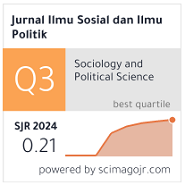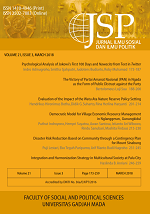Evaluation of the Impact of the Watu Ata Nature Reserve Policy Setting
Hendrikus Hironimus Botha(1*), Didik G. Suharto(2), Rina Herlina Haryanti(3)
(1) Public Administration Master Program, Faculty of Social and Political Sciences, University of Sebelas Maret
(2) Public Administration, Faculty of Social and Political Sciences, University of Sebelas Maret
(3) Public Administration, Faculty of Social and Political Sciences, University of Sebelas Maret
(*) Corresponding Author
Abstract
The major theme of this paper is to evaluate policy impacts. This paper aims to evaluate the impact of the determination of the Watu Ata Nature Reserve using the evaluation criteria proposed by William N. Dunn: Effectiveness, Equity, Responsiveness and Appropriateness. As defined in RI Government Regulation No. 28 of 2011 Article 1, a nature reserve is an area which, due to its natural condition, contains unique plants and/or plant diversity along with natural phenomena and whose ecosystem requires protection and preservation efforts so that its existence and development can grow naturally. The Watu Ata Nature Reserve is one nature reserve area in the Ngada regency based on the Decree of Minister of Forestry No. 432/Kpts-II/92. The research method used is a descriptive qualitative study that employs a field study approach conducted in two villages, namely, Heawea Village and Inelika Village. These two villages have the biggest community’s land in the Watu Ata Nature Reserve. The findings suggest that the Watu Ata Nature Reserve policy has had a negative impact on people living around the nature reserve area, particularly with respect to their loss of access to the cultivated land and cultural sites where they have built relationships with their deceased ancestors.
Keywords
Full Text:
PDFReferences
S, M. A., M., & Prasetya, W. Y. (2014). Evaluasi dampak kebijakan pembangunan Pelabuhan Perikanan Pantai (PPP) Tamperan terhadap perubahan sosial ekonomi masyarakat pesisir sekitar (Studi Kasus pada PPP Tamperan Kab. Pacitan). Jurnal Administrasi Publik, 2(11), 1010-1015. Retrieved from http://administrasipublik.studentjournal. ub.ac.id/index.php/jap/article/view/667
Bungin, B. (2009). Penelitian kualitatif: komunikasi, ekonomi, kebijakan publik, dan ilmu sosial lainnya. Jakarta: Kencana Prenada Media.
Cahyono, E. (2013). Eksklusi atas nama konservasi (studi kasus masyarakat sekitar/dalam kawasan Taman Nasional Ujungkulon Banten). Jurnal Sosiologi Reflektif, 8(1), 209-245. Retrieved from http://ejournal.uin-suka.ac.id/isoshum/sosiologireflektif/article/view/519.
Dunn, W. N. (2003). Pengantar analisis kebijakan publik. Yogyakarta: Gadjah Mada University Press.
Djadmiko. (2007). Evaluasi pengelolaan kawasan cagar alam mandor di kabupaten Landak Propinsi Kalimantan Barat (Master’s thesis, Semarang, 2007). Semarang: Universitas Diponegoro.
Guan, Z., & Gong, P.(2015). The impacts of international efforts to reduce illegal logging on China’s forest products trade flow. China Agricultural Economic Review, 7(3), 467-483. doi: 10.1108/caer-12-2014-0134
Government Regulation of the Republic of Indonesia No. 28 of 2011 on Management of Nature Reserve Area and Nature Conservation Area
Hwang, Y. H., Feng, Y., & Tan, P. Y. (2016). Managing deforestation in a tropical compact city (Part B): Urban ecological approaches to landscape design. Smart and Sustainable Built Environment, 5(1), 73-92. doi: 10.1108/sasbe-08-2015-0023
Koli, Y. (2010). Mengubah Cagar Alam Watu Ata (Sebuah Pengalaman Advokasi Kebijakan Publik): Sloka institute, Lapmas Ngada, dan VECO Indonesia
Koli, Y. (2009, November 9). Bongkar Ulang Cagar Alam Watu Ata. Tribunnews . Retrieved March 3, 2016 from http://kupang. tribunnews.com/2009/11/09/bongkar- ulang-cagar--alam-watu-ata.
Kusumanegara, S. (2009). Model dan aktor dalam proses kebijakan publik. Yogyakarta: Gava Media.
Mulyadi, D. (2015). Studi kebijakan publik dan pelanan publik. Bandung: Alfabeta.
Medugu, I. N., Majid, M. R., Johar, F., &Taiwo, I. S. (2014). Assessing the impact of Forestry II program on agricultural productivity in the Arid Zone of Nigeria: A case of Kano and Jigawa State. Management of Environmental Quality: An International Journal, 25(6), 783-801. doi: 10.1108/meq-05-2013-0038
Parsons, W. (2008). Public policy: pengantar teori dan praktik analisis kebijakan. Jakarta: Kencana.
Pramono, A. H. (2014). Perlawanan atau Pendisiplinan? Sebuah Refleksi Kritisatas Pemetaan Wilayah Adat. Wacana Jurnal Transformasi Sosial. 33, 207-242.
Subarsono, AG. (2013). Analisa kebijakan publik, konsep, teori dan aplikasi. Yogyakarta: Pustaka Pelajar.
Kementerian Kehutanan. (2014). Statistik kementerian kehutanan. Jakarta: Kementerian Kehutanan.
Tim Inkuiri Nasional Komnas HAM. (2016). Inkuiri Nasional Komisi Nasional Hak Asasi Manusia: Hak Masyarakat Hukum Adat Atas Wilayah di Kawasan Hutan. Jakarta: Komisi Nasional Hak Asasi Manusia Republik Indonesia
Babak Baru Perjuangan Rakyat Watu Ata. (2011, May 10). Retrieved March 3, 2016, from http://www.berdikarionline.com/babak- baru-perjuangan-rakyat-watu-ata/
Verbist, B.&Pasya, G. (2004). Perspektif sejarah status kawasan hutan, konflik dan negosiasi di Sumberjaya, Lampung Barat-Propinsi Lampung. Jurnal Agrivita, 26(1), 20-29.
Wibawa, S. (1994). Evaluasi kebijakan publik. Jakarta: Raja Grafindo Perkasa.
Article Metrics
Refbacks
- There are currently no refbacks.
Copyright (c) 2018 JSP (Jurnal Ilmu Sosial dan Ilmu Politik)

This work is licensed under a Creative Commons Attribution-NonCommercial-NoDerivatives 4.0 International License.






















